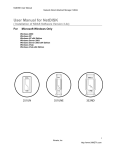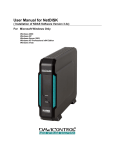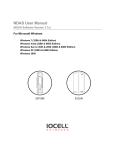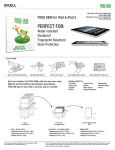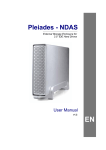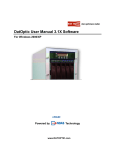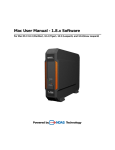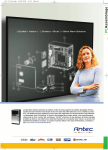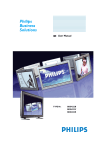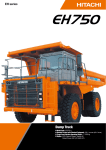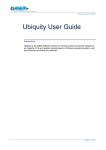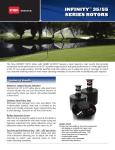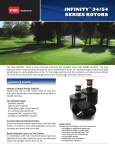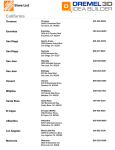Download User Manual for NetDISK
Transcript
NetDISK User Manual Network Direct Attached Storage / NDAS User Manual for NetDISK ( Installation of NDAS Software Version 3.3x) For Microsoft Windows Only Windows 2000 Windows XP Windows Server 2003 Windows XP Professional x64 Edition Windows Vista Windows Server 2008 IOCELL Networks Corp. NetDISK User Manual Network Direct Attached Storage / NDAS IOCELL Networks Corp. 161 Whitney Place Fremont, CA 94539 United States of America Software Release Statement User Manual for Microsoft Windows. Software Version 3.3x, released 2008, made in the U.S.A. Trademark Statement NetDISK® , NDAS® and IOCELL Networks are trademarks of IOCELL Networks Corp., registered in the U.S.A and other countries. All other trademarks are the property of their respective owners. Copyright Statement Copyright © 2008 IOCELL Networks Corp. All rights reserved. Reproduction, translation, transformation or adaptation in any manner without prior written permission of IOCELL Networks is strictly prohibited. License Statement The software described in this document is furnished under a license agreement. The software may be used only in accordance with the terms of the license agreement Warranty Statement IOCELL Networks. reserves the right to revise this publication and to make changes to the content hereof without the obligation of IOCELL Networks to notify any person of such revision or changes. IOCELL Networks provides this publication “as is” without warranty of any kind, either expressed or implied, including but not limited to the implied warranties of merchantability or fitness for a particular purpose. Product Warranty Please see Chapter 14 for complete product warranty coverage. IOCELL Networks Corp. NetDISK User Manual Network Direct Attached Storage / NDAS Table of Contents 1 2 3 4 5 6 7 8 9 10 11 12 13 14 14 Introduction ············································································································································ 4 1.1 User Manual .................................................................................................................................. 4 1.2 Package Contents ......................................................................................................................... 4 1.3 System Requirements ................................................................................................................... 5 1.4 NDAS device Setup Overview ...................................................................................................... 5 Cable Installation ··································································································································· 6 2.1 NDAS Mode .................................................................................................................................. 6 2.2 USB Mode ..................................................................................................................................... 7 NDAS Software Installation ··················································································································· 8 3.1 For Windows XP and Windows 2000 ............................................................................................ 8 NDAS device Registration ··················································································································· 11 4.1 Add / Register a New NDAS device Using The Registration Wizard ........................................... 11 4.2 Found New Hardware Wizard ...................................................................................................... 13 4.3 Using NDAS device ...................................................................................................................... 14 4.4 Sharing NDAS device .................................................................................................................. 15 Introduction To NDAS device Manager ······························································································ 16 5.1 NDAS device Status Mode .......................................................................................................... 16 5.2 NDAS device Management .......................................................................................................... 17 NDAS device Functions ······················································································································· 18 6.1 NDAS device Management ......................................................................................................... 18 6.2 Changing from Read/Write to Read-Only Mode ........................................................................... 21 6.3 Changing from Read-Only to Read/Write Mode ........................................................................... 22 6.4 Using NDAS device Properties .................................................................................................... 23 6.4.1 General .......................................................................................................................... 23 6.4.2 Hardware ....................................................................................................................... 23 6.4.3 Hosts .............................................................................................................................. 23 6.4.4 Advanced ....................................................................................................................... 24 NDAS Bind Management ······················································································································ 25 7.1 Bind…… ........................................................................................................................................ 25 7.1.1 Requirements For Bind .................................................................................................. 26 7.1.2 Connected Mode ............................................................................................................ 26 7.1.3 Instructions For Bind ....................................................................................................... 26 7.2 Unbind ........................................................................................................................................ 29 7.2.1 Unbind All ..................................................................................................................... 29 7.2.2 Unbind A Single NDAS device ....................................................................................... 30 Other NDAS Bind Management Functions ························································································· 32 8.1 Other NDAS Bind Management Functions ................................................................................... 32 8.1.1 Add Mirror ....................................................................................................................... 32 8.1.2 Migrate ............................................................................................................................ 32 8.1.3 Replace Drive ................................................................................................................. 32 8.1.4 Replace HDD .................................................................................................................. 32 8.1.5 Add Spare Disk ............................................................................................................... 33 8.1.6 Remove Spare Disk ........................................................................................................ 33 8.2 Using Mirrored NDAS device ....................................................................................................... 34 8.2.1 Upgrading the driver without braking the Mirrored NDAS device .................................... 34 8.2.2 Using bound NDAS device among different driver versions ........................................... 34 Formatting NDAS device ····················································································································· 35 9.1 Initialize NDAS device ................................................................................................................. 35 9.2 Partition NDAS device ................................................................................................................. 36 9.3 Format NDAS device Through My Computer ............................................................................. 36 Uninstall ················································································································································ 39 NDAS Command Line Utility ················································································································· 40 FAQ ······················································································································································ 41 Regulatory Statement ··························································································································· 47 Product Warranty ································································································································· 48 Additional Information And Assistance ······························································································· 51 IOCELL Networks Corp. NetDISK User Manual Network Direct Attached Storage / NDAS 1 Introduction Congratulations on your purchase of the NetDISK. (Note: From this point forward, NDAS device will be used as the same meaning of NetDISK unless otherwise noted.) Network storage via Ethernet made possible through NDAS technology! 1.1 User Manual This User Manual is intended to help you install NDAS device quickly and easily onto your Personal Computer or Ethernet Network and begin using it immediately. 1.2 Package Contents The following items are included in the NDAS device packages: (items varies with model) • NDAS device (Picture varies with model) • Software Installation CD • Ethernet Cable / USB Cable Ethernet Cable USB Cable • Power Adapter and Power Cord NetDISK 251UN NetDISK 351UE / 351UNE / 352ND IOCELL Networks Corp. NetDISK User Manual Network Direct Attached Storage / NDAS 1.3 System Requirements Supported Operating Systems • Microsoft Windows 2000 • Microsoft Windows XP • Microsoft Windows Server 2003 • Microsoft Windows XP Professional x64 Edition • Microsoft Windows Vista • Microsoft Windows Server 2008 Required Hardware • 233 MHz Pentium or higher • 64 MB RAM (128 MB recommended) • USB 1.1 Port (USB 2.0 recommended) • CD-ROM drive for installation • 100Base-T full duplex switch for NDAS mode • Gigabit Ethernet switch and gigabit Ethernet network card mode are recommended for NDAS device Giga Note: NDAS devices cannot be used with any type of Hub. 1.4 NDAS device Setup Overview IOCELL Networks Corp. NetDISK User Manual Network Direct Attached Storage / NDAS 2 Cable Installation Warning Do not connect USB cable and Ethernet cable at the same time. 2.1 NDAS Mode Note: NDAS software does need to be installed on each computer in order to use in NDAS (Ethernet) mode. 1. If your NDAS device has dip switches on the rear panel, flip both dip switches down. 2. Connect the included Ethernet cable from the Ethernet port on NDAS device to a switch (100 Base-T). Wireless users: Connect NDAS device to your wireless router or access point with included Ethernet cable. 3. Make sure the power connector is firmly attached to the NDAS device and connect the power adapter to a power source. 4. If your NDAS device has an On/Off switch, press the On/Off Switch to ON position. 2.2 USB Mode Note: NDAS software does not need to be installed to use in USB mode. 1. If your NDAS device has dip switches on the rear panel, flip both dip switches up. 2. Connect the included USB cable from USB port on NDAS device to your PC’s USB port. 3. Make sure the power connector is connected firmly to the NDAS device and connect the power adaptor to a power source. 4. If your NDAS device has an On/Off switch, press the On/Off Switch to ON position. IOCELL Networks Corp. NetDISK User Manual Network Direct Attached Storage / NDAS 3 NDAS Software Installation 3.1 Installing NDAS 3.3x software Installation of the NDAS software is simple and easy. If downloading software, please unzip the driver and click on setup.exe to begin installation. If you are using the Installation CD, insert the CD into your CD-ROM drive and select Windows Driver. 1. NDAS Install Wizard appear. Click the Next button to continue to next step. 2. Accept License Agreement and the click Next to continue installation. IOCELL Networks Corp. NetDISK User Manual Network Direct Attached Storage / NDAS 3. Click the Install button to install drivers. 4. Please wait while installation continues. IOCELL Networks Corp. NetDISK User Manual Network Direct Attached Storage / NDAS 5. Click Yes or Continue Anyway if one of these windows come up. 6. Click the Finish button to complete. 7. Click on the Yes button to restart your computer if this window comes up. (restart required for NDAS device to function) IOCELL Networks Corp. NetDISK User Manual Network Direct Attached Storage / NDAS 4 NDAS device Registration Note: You can register using the Registration Wizard or without it. 4.1 Add / Register a New NDAS device using the Registration Wizard 1. Click on the NDAS device Management Icon located on the system tray. 2. Select Register A New Device. 3. NDAS device Registration Wizard will appear. Click Next to continue. 4. Enter a name for the NDAS device. Click Next. IOCELL Networks Corp. NetDISK User Manual Network Direct Attached Storage / NDAS 5. Add your NDAS device ID and Write Key. The Write Key is needed to write to your NDAS device. Once entered, click Next to continue. Note: NDAS device ID and Write Key does not contain the letter O. Please use the number 0 for all letter 0s. If your NDAS device ID and Key are not typed in correctly, The ‘Next’ button will not be selectable. 6. Select how you want to mount the NDAS device. Read/Write Mode: Mounts NDAS device as Read/Write Mode. Note: Read/Write Mode will be disabled if a user did not enter the Write Key during step 5. Read-Only Mode: Mounts NDAS device as Read-Only Mode. Don’t Mount: NDAS device is left in Connected (Dismounted) Mode. IOCELL Networks Corp. NetDISK User Manual Network Direct Attached Storage / NDAS 7. Registration is finished. Click Finish. 4.2 Found New Hardware Wizard 1. After you have registered, the Found New Hardware Wizard should appear. Note: Depends on the Windows version, the look of Hardware Wizard may have different look or will not appear. • If the window appears, click Next, Yes or Continue Anyway to install the new NDAS device. IOCELL Networks Corp. NetDISK User Manual • Network Direct Attached Storage / NDAS It should automatically find the appropriate drivers for your NDAS device. IOCELL Networks Corp. NetDISK User Manual Network Direct Attached Storage / NDAS 2. If the Windows Logo Testing message comes up, click Yes or Continue Anyway to finish the installation. Windows 2000, click Yes Windows XP, click Yes IOCELL Networks Corp. NetDISK User Manual Network Direct Attached Storage / NDAS 3. Registration is completed. • Click NDAS device Management Read/Write Mode to see the registered NDAS device. Read-Only Mode Note: If you cannot see your NDAS device, please click Refresh Status and check again. IOCELL Networks Corp. NetDISK User Manual Network Direct Attached Storage / NDAS 4.3 Using NDAS device Now that you have successfully installed NDAS device, it is time to familiarize yourself with using the NDAS device. Your NDAS device will show up as a local drive in My Computer. Drive letter and NDAS device name may vary between Personal Computers. You can use NDAS device like a local drive on your PC. • Drag and drop files to NDAS device. • Copy and paste data to NDAS device. • Make and delete folders. • Share files and folders. • Backup your data 4.4 Sharing NDAS device Once NDAS device is connected to your network, it can be accessed from any computer on your LAN. To share NDAS device, the following must occur: Windows 2000/XP/2003/Vista/2008 Environment: • All computers and NDAS device must be on the same LAN. • NDAS device must be connected via Ethernet or Wireless Router. IOCELL Networks Corp. NetDISK User Manual • • Network Direct Attached Storage / NDAS To share Read and Write access, all computers on the network using the NDAS device must have the NDAS driver version 3.3x installed. NDAS device must be registered onto each computer. Warning: • • DO NOT perform disk operations (format, partition and chkdsk) when multiple PCs have the NDAS mounted. NDAS device can be formatted, partitioned, chkdsk, aggregated or mirrored ONLY when one PC is connected. IOCELL Networks Corp. NetDISK User Manual Network Direct Attached Storage / NDAS 5 Introduction to NDAS device Management 5.1 NDAS device Status Modes NDAS device provides users with six basic Modes. Below is a chart describing each of the NDAS device Modes and the icons that correspond with each Mode. NDAS device Color Green (Mounted RO) Blue (Mounted RW) White (Ready) Black (Disconnected) Gray (Identifying) Red w/ Slash (Deactivated) Icon Mode / Meaning Read-Only Mode Users can only read from NDAS device Read / Write Mode Users can read/write from/to NDAS device Ready NDAS device is ready to be mounted Read-Only Mode NDAS device is registered but your system cannot find the NDAS device. Power Cord, Ethernet Cord or USB Cord may be unplugged. Make sure any Antivirus/Firewall software or Spyware is not interfering with the connection. Read-Only Mode NDAS device is being identified its status. Read-Only Mode NDAS device is deactivated and needs to be Activated. Click on the NDAS device Management menu and click on Activate. IOCELL Networks Corp. NetDISK User Manual Red (Error) Network Direct Attached Storage / NDAS Read-Only Mode There is a communication error between your computer and the NDAS device. Power Cycle the NDAS device and reboot the computer IOCELL Networks Corp. NetDISK User Manual Network Direct Attached Storage / NDAS 5.2 NDAS device Management Click the NDAS device Management located on the system tray. All registered NDAS device(s) will be displayed on the NDAS device Management Menu. • • • • • • • When you click on the icon Lists all NDAS devices that are registered. Register a New Device Registers a NDAS device to your computer. Refresh Status Updates status of your NDAS device. About Displays NDAS software version information. Check for Updates: Checks IOCELL Networks website for updated drivers. Options Can customize NDAS device Management features and error messages / dialogs. Exit Exits NDAS device Management. NDAS device Management can be restored by selecting Programs -> NDAS Software -> NDAS device Management at start menu. IOCELL Networks Corp. NetDISK User Manual Network Direct Attached Storage / NDAS 6 NDAS device Functions 6.1 NDAS device Management Click NDAS device Management and place the cursor on a NDAS device to view its functions. Below is a list of the NDAS device Modes and related functions. Note: The Yellow box is there to show the current mode status of your NDAS device. It cannot be selected. For more information, please see the section on page - 20 -. A. NDAS device mounted in Read/Write Mode • • • Mounted (RW) - The current state of the NDAS device. Dismount - Enables users to change NDAS device mode to Connected Mode. Properties - Displays properties of the NDAS device. B. NDAS device mounted in Read-Only Mode • • • Mounted (RO) - The current state of the NDAS device. Dismount - Enables users to change NDAS device mode to Connected Mode. Properties - Displays properties of the NDAS device. IOCELL Networks Corp. NetDISK User Manual Network Direct Attached Storage / NDAS C. NDAS device in Offline Mode • • • Offline - The current state of the NDAS device. Deregister - Enables users to un-register NDAS device. Properties - Displays properties of the NDAS device. D. NDAS device in Connected Mode • • • • • Online - The current state of the NDAS device. Mount (Read-only) - NDAS device can be mounted into Read-Only Mode. Mount (Read/Write) - NDAS device can be mounted into Read/Write Mode. Deregister - Enables users to un-register NDAS device. Properties - Displays properties of the NDAS device. IOCELL Networks Corp. NetDISK User Manual Network Direct Attached Storage / NDAS E. NDAS device mounted in Read/Write Mode • • • • Deactivated - The current state of the NDAS device. Activate - Enables NDAS device to be activated into Connected Mode. Once activated NDAS device will be indicated by white colored box. Deregister - Enables users to un-register NDAS device. Properties - Displays properties of the NDAS device. 6.2 Changing from Read/Write Mode to Read-Only Mode 1. Click NDAS device Management and select the NDAS device you want to change from Read/Write to Read-Only. 2. Select Dismount 3. A warning will appear. Click Yes. IOCELL Networks Corp. NetDISK User Manual 4. Click NDAS device Management Select Mount(Read-only). Network Direct Attached Storage / NDAS . The status icon is now changed to white. 5. The White Square will change to a Green Square indicating Read-Only Mode. 6.3 Changing from Read-Only Mode to Read/Write Mode 1. Click NDAS device Management and select the NDAS device you want to change from Read-Only to Read/Write. 2. Select Dismount 3. A warning will appear. Click Yes. IOCELL Networks Corp. NetDISK User Manual 4. Click NDAS device Management Select Mount(Read/Write). Network Direct Attached Storage / NDAS . The status icon is now changed to white. 5. The White Square will change to a Blue Square indicating Read/Write Mode. IOCELL Networks Corp. NetDISK User Manual Network Direct Attached Storage / NDAS 6.4 Using NDAS device Properties Clicking on your NDAS device Management and going into the properties of your NDAS device will display useful information about your NDAS device hardware. 6.4.1General This will display information such as the Device Name, Status, and display how many users have the NDAS device mounted in RW or RO mode. Also displays the capacity of the hard drive within your NDAS device. IOCELL Networks Corp. NetDISK User Manual Network Direct Attached Storage / NDAS 6.4.2Hardware Hardware displays detailed information regarding the Chipset of your NDAS device, Mac Address, as well as detailed information regarding the Hard Drive within your enclosure. Having the Mac Address of your NDAS device will be useful if utilizing Mac Address Filtering within your Network. IOCELL Networks Corp. NetDISK User Manual Network Direct Attached Storage / NDAS 6.4.3Hosts Hosts will display to you everyone that has the NDAS device mounted. Whether they have Read/Write Access or Read Only access this section will display the computer’s name as well as their IP address. This is useful when you want to find out who has access to your NDAS device IOCELL Networks Corp. NetDISK User Manual Network Direct Attached Storage / NDAS 6.4.4Advanced Advanced has several different options to use with your NDAS device. Deactivate, Reset, and Export are 3 options you will have. Below we will explain their features. Deactivate - This feature will stop all communication from your computer to the NDAS device. It must be activated in order to mount it again. Reset - Reset will completely reset the connection of your NDAS device. This will be useful is you are having trouble communicating to the NDAS device. Export - This useful tool will allow you to export the NDAS device ID and Key so that it can be imported into another computer. This prevents you from having to manually type in the ID and Key on each system. IOCELL Networks Corp. NetDISK User Manual Network Direct Attached Storage / NDAS Once complete the exported ID will appear as to add the exported information to your NDAS software, simply double click on the saved icon. IOCELL Networks Corp. NetDISK User Manual Network Direct Attached Storage / NDAS 7 NDAS Bind Management 7.1 About NDAS Bind Multiple NDAS devices can be used as if they are a single disk. This is called a NDAS bind and it can be created and managed by NDAS Bind Management tool. You can bind multiple NDAS devices for more capacity per volume, more performance or protection from hard disk failures. NDAS support three bind types: Aggregation, Stripe (RAID0) and Mirror (RAID1). A. Aggregation (also called spanned disk or JBOD) • Allows any number of the NDAS device units between 2 and 8 to be recognized as a single disk drive. • Useful when a larger storage device is needed. • This bind does not provide any fault tolerance. If any one unit fails, all data is lost. B. Stripe (also called RAID0) • Allows 2, 4, or 8 NDAS device units to be recognized as a single disk drive. • Useful when a larger storage device is needed. • This bind does not provide any fault tolerance. If any one unit fails, all data is lost. • Every read/write access is split into each disk. So if you have a proper network equipment and network layout, you can get better performance. Warning: Because the block size of the striped disks is not 512 bytes, some applications or operating systems may not access striped devices correctly. C. Mirror (also called RAID1) D. Allows 2 NDAS device units to be mirrored. You can add one more NDAS unit device as a spare disk. E. Provides fault tolerance. All data is written to both devices, so data can be accessed even after one device fails. Warning: Mirroring (RAID1) protects data only from hard disk failure. It cannot protect data from logical error such as file system error or incorrectly written data by application software. You need to backup your data to storage regularly to prevent these kinds of data loss. IOCELL Networks Corp. NetDISK User Manual Network Direct Attached Storage / NDAS 7.2 NDAS Bind Management You can run NDAS Bind Management tool from Windows Start > Programs > NDAS Software > NDAS Bind Management menu. You can create, remove and configure NDAS bind using this tool and you can also check current status of the bind from it. You can operate NDAS devices or NDAS bind by selecting and clicking right mouse button. 7.3 Before bind All NDAS devices to bind must be registered with write key and must be online status. And they must not be mounted on any PCs including the PC which performs the bind operation. Make sure that all NDAS devices to bind is in Ready status. If the device is In use status, check which PC has mounted the devices using Properties menu > Hosts tab and dismount the device from the PC. And press Refresh button or F5 key to refresh. IOCELL Networks Corp. NetDISK User Manual Network Direct Attached Storage / NDAS 7.4 Creating Mirror without destroying data Use Add Mirror menu to create a mirror (RAID1) while keeping the contents of disk. 1. Select NDAS device which you want to keep data and click right mouse button. 2. Select Add Mirror menu and than select a device that you want to use as a mirrored disk. 3. Synchronizing process will be started once you have mounted the devices in read/write mode. But until devices are fully synchronized, they will run in recovery mode. In this mode, you can access the contents but the access speed may be slow. And mirror (RAID1) cannot protect data against original disk's failures in this mode. So it is recommended to wait until synchronization is completed before use. IOCELL Networks Corp. NetDISK User Manual Network Direct Attached Storage / NDAS 4. You can check the current progress of synchronization from NDAS Bind Management. IOCELL Networks Corp. NetDISK User Manual Network Direct Attached Storage / NDAS 7.5 Creating new bind Warning: • • All data on the disks will be deleted once bind is completed. Some versions of MS Windows operation system do not recognize storage larger than 2TB (2048 Giga bytes). If you want to use a single large volume, you need to use Windows 2003 server SP1, Windows XP x64 edition, Windows Vista or later. 1. Click "Bind" icon on the toolbar to start NDAS Bind Wizard. Select a bind type and the number of disks to use. 2. Select NDAS devices to use as bind members. IOCELL Networks Corp. NetDISK User Manual Network Direct Attached Storage / NDAS 3. Check the result pages whether the bind operation is completed successfully. IOCELL Networks Corp. NetDISK User Manual Network Direct Attached Storage / NDAS IOCELL Networks Corp. NetDISK User Manual Network Direct Attached Storage / NDAS 7.6 Using bound devices After binding, you can mount the bind as a usual NDAS device. But you need to format the devices to use. To do so, select any one of the Bound NDAS device and Mount (Read/Write). "Found New Hardware Wizard" may appear. Click NEXT and proceed in finishing the wizard. And please format the new NDAS bind according to "Chapter 9 Formatting NDAS devices." In some cases, "Mount (Read/Write)" and "Mount (Read-only)" menu can be disabled. This means that the bind is not in mountable status. You can check further information at "Properties" menu and NDAS Bind Management. IOCELL Networks Corp. NetDISK User Manual Network Direct Attached Storage / NDAS IOCELL Networks Corp. NetDISK User Manual Network Direct Attached Storage / NDAS 7.7 Migrate from previous version of the NDAS software Some bind types that created by previous version of the NDAS software need a migration to be used by current version of software. Once migrated, the bind cannot be used by the older version of software anymore. IOCELL Networks Corp. NetDISK User Manual Network Direct Attached Storage / NDAS 7.8 Unbind You can unbind the bound NDAS device by selecting it and using "Unbind" button or menu. If any member device is not available when unbinding, bind information on that device will not be updated. You need to unbind again for the device. Warning: Data on aggregation, stripe (RAID0) bind types are not accessible once unbinding is done. You can still use the devices as a basic disk after unbinding Mirror (RAID1) but data on each device may not be valid if the bind was not healthy state. IOCELL Networks Corp. NetDISK User Manual Network Direct Attached Storage / NDAS 7.9 Managing Bind There are some operations that can change configuration of bind after it is made and used. Bind configuration can be only changed while it is not used by any PCs. You can check what operation is available by right clicking on the bound device or each member device. Each operation menu becomes available only when the operation can be applied. Add Spare Disk You can add one spare disk to Mirror (RAID1) bind type. If Mirror (RAID1) bind has a spare disk, spare disk will be used when one of the bind member devices is unavailable or found to be defective. Spare disk should be large enough to be member of Mirror (RAID1). IOCELL Networks Corp. NetDISK User Manual Network Direct Attached Storage / NDAS Reset bind information Bind information is stored on the disk. And it can be corrupted or may not be valid for some reason, such as replaced disk and disk IO error. You can use Reset bind information menu to reset this information to a default value. IOCELL Networks Corp. NetDISK User Manual Network Direct Attached Storage / NDAS Replace Device You can replace a member of Mirror (RAID1) bind. You need to use this menu when the hard disk have bad sector or a NDAS device becomes unavailable and you want to use replace the unit with another NDAS device. Once a member is replaced, it may need synchronizing process. IOCELL Networks Corp. NetDISK User Manual Network Direct Attached Storage / NDAS Use as a RAID member In some case, a member of Mirror (RAID1) bind can be configured as a non-active member or member of another bind. You can use Use as a RAID member menu to use it as a member device again. For example, you can use this menu when the spare disk is used. When Mirror (RAID1) with spare disk has lost connection to a member disk and the spare disk is used, lost member is marked as replaced by spare disk. And the device will not be used as a active member until the user select it to use as RAID member using Use as a RAID member menu. IOCELL Networks Corp. NetDISK User Manual Network Direct Attached Storage / NDAS Clear Defective Mark If any bad sectors are detected while accessing Mirror (RAID1) bind, the device with bad sectors will be marked as defective disk. In most case, it is recommended to replace the disk. But if you want to continue to use the disk, you can just clear the defective mark to retry. Configure RAID without this disk If Mirror (RAID1) has a spare disk, you can remove one member disk using Configure RAID without this disk. This operation can be useful if you want to remove a defective member or want to remove a spare disk. IOCELL Networks Corp. NetDISK User Manual Network Direct Attached Storage / NDAS IOCELL Networks Corp. NetDISK User Manual Network Direct Attached Storage / NDAS 7.10 NDAS Bind Terms Degraded mode Even if one NDAS device fails while accessing Mirror (RAID1) bind, you can still access the data. But redundancy is not available in this state and it is called degraded mode. If another NDAS device fails in this mode, Mirror (RAID1) become unusable. So you need to replace the defective device as soon as possible. Spare disk A spare disk is automatically used when Mirror (RAID1) enters degraded mode. The spare disk will be used as active member of RAID. Even if spare disk is used, RAID will be in degraded mode during desynchronizing. Irreconcilable state When each member of Mirror (RAID1) is used in degraded mode independently, the data on the devices may have different copy data. Because both copies may be valid data, it can not be resolved automatically. A user needs to solve this case by replacing one of the disks or unbind. Resynchronization When using Mirror (RAID1), same data is written to each member device. But when one of the devices was unavailable or a device is added later to the bind, two devices don't have same copy of data. So Mirror (RAID1) system need to copy data from one device to another and this process is called resynchronization. Out-of-sync The member of Mirror (RAID1) is not identical to another member and may have not valid data. IOCELL Networks Corp. NetDISK User Manual Network Direct Attached Storage / NDAS 8 Formatting NDAS device 8.1 Initialize NDAS device 1. Right click My Computer and select Manage. 2. Computer Management window will appear. Click Disk Management under Storage. 3. Computer Management window will list all the disks in the computer. 4. Find the NDAS device you want to initialize. • • The NDAS device is usually indicated by Not Initialized. If the NDAS device is described as Basic or Healthy, skip to Chapter 9.2 Partition NDAS device. Otherwise, go to next step. 5. Initialize NDAS device IOCELL Networks Corp. NetDISK User Manual • • Network Direct Attached Storage / NDAS Right click on the Disk # that pertains to your NDAS device and select Initialize Disk. Initialize Disk window will appear. Select the NDAS device and click OK. 6. NDAS device will be automatically initialized • Unknown becomes Basic . Note: It is VERY important that your NDAS device is listed as a Basic Disk and not a Dynamic one. 7. Initialization is completed. • Before NDAS device can be used, it must be partitioned. See Chapter 9.2 . IOCELL Networks Corp. NetDISK User Manual Network Direct Attached Storage / NDAS 8.2 Partition NDAS device 1. From the Computer Management window, find the NDAS device you want to format. 2. Right click and select New Partition. 3. New Partition Wizard: Click next. 4. Select Partition Type: • Select Primary partition. • Click Next. 5. Specify Partition Size: • Click Next. IOCELL Networks Corp. NetDISK User Manual Network Direct Attached Storage / NDAS NOTE: The partition size is automatically set. Do not change the size. 6. Assign Drive Letter or Path: • Select Assign the following driver letter. • Choose a letter for the drive from list. • Click Next. IOCELL Networks Corp. NetDISK User Manual Network Direct Attached Storage / NDAS 7. Format Partition: • Select Format this partition with the following Settings. • File System: NTFS IOCELL Networks Corp. NetDISK User Manual • • Network Direct Attached Storage / NDAS • Allocation unit size: Default • Volume Name: Enter a name for the disk. Select Perform a quick format (Recommended). Click next. 8. Partitioning is finished. Click Finish. • You can see the partitioned disk. IOCELL Networks Corp. NetDISK User Manual Network Direct Attached Storage / NDAS 8.3 Format NDAS device Through My Computer 1. Double click on My Computer. 2. My Computer window will appear. Right Click on your NDAS device choose Format 3. The Format window will appear with a few options. Check the box that says Quick Format (Recommended) 4. A Warning will appear asking if you are sure you want to format the drive. Click on OK. IOCELL Networks Corp. NetDISK User Manual Network Direct Attached Storage / NDAS 5. Click on OK once the format has completed. IOCELL Networks Corp. NetDISK User Manual Network Direct Attached Storage / NDAS 9 Uninstall Before you can uninstall a NDAS device, you must close all applications using the NDAS device. NDAS Disk Management, NDAS Bind Management, Windows Explorer and Internet Explorer must also be closed. • Close NDAS Disk Management by selecting Exit. • Uninstall NDAS device. • Go to Start > Programs > NDAS Software > Uninstall NDAS Software • Windows Installer will appear. Click Yes if you want to continue. Otherwise click No. IOCELL Networks Corp. NetDISK User Manual Network Direct Attached Storage / NDAS Note: A warning window may appear if any of the NDAS devices is still in mounted state. Click Cancel and dismount the NDAS devices. • Restart the PC once uninstalls is finished. IOCELL Networks Corp. NetDISK User Manual 10 Network Direct Attached Storage / NDAS NDAS Command Line Utility Included with the 3.11 Driver is an option to run your NDAS software from a command line interface. *Please Note: These options are for Advanced users only* 1. Open your Command Line and type in the following command. cd Program Files \ NDAS \ System This should bring you to the path C: \ Program Files\NDAS\System 2. Next, type in ‘ndascmd /? ’. This will load the NDAS command line help. The Syntax for the interface should be as follows. ndascmd <command> [parameters] The command can be one of the following. • • • • • • • • • • • • register <device name> <device id> [write key] unregister <device number> list devices list logdevices mount [/wait] <ldn> — /device <dn> ro—rw unmount [/force] [/wait] <ldn> — /device <dn> dismount [/force] [/wait] <ldn> — /device <dn> syncdismount <ldn> — /device <dn> activate <device-number> deactivate <device-number> query device hosts <device-number> purge <volume-path> (e.g. C: or \\? \C:) NDAS Command Notes • ldn - Logical Device Number - Can be found by using ‘list devices’ • dn - Device Name - Name given to the NDAS device in the NDAS software IOCELL Networks Corp. NetDISK User Manual Network Direct Attached Storage / NDAS 11 FAQ For the most recent list of FAQs, please visit http://www.iocellnetworks.com 11.1 General 1. What can NDAS device be used for? NDAS device can be used with a variety of applications. It is ideal for all users that cannot afford NAS systems, such as small to medium businesses, SOHO (Small Office Home Office), workgroups, departments, schools and public institutions. NDAS technology’s convenience and low cost provides the best storage solution for home / office networking. • Use as storage for Personal Computer and Home Networking (storing and sharing files, backup / archiving, etc.) • Expanding storage requirements. • Business primary or secondary network storage. • Public institution’s storage for data archives, disclosed data, backups, and data conservation. • Multimedia storage device (MP3s, Digital Photos, Digital Video). • Multi-platform networking (Simultaneous read-only use from Macintosh and Windows) • Non-PC / Non-Computing applications (security, CCTV, technograph recording, MRI, entertainment). 2. How is NDAS different from NAS or SAN? NDAS is a better alternative to NAS or SAN. NDAS is much more cost-effective, efficient and easy to use. It is for users looking for lower costs and storage associated with backup / archiving. Although both NDAS and NAS are storage devices that are implemented over a network, NDAS takes up less space than NAS or SAN products. NDAS utilizes NDAS technology allowing it to connect the hard disk directly to a network without a server. In NAS, the hard disk must be connected to a storage server, which must also be connected to the network. 3. For NDAS mode, do I need drivers installed on each computer using NDAS device? Yes, the drivers need to be loaded on each computer that wants access to NDAS device. However, if you are using Windows Sharing, only one computer will need the software installed (Computer must be on as a “Host” computer). The other computers will not need it. IOCELL Networks Corp. NetDISK User Manual 11.2 Network Direct Attached Storage / NDAS Windows 2000 / XP 1. I am having trouble using Multi-write over wireless/wired connection. What do you recommend? Try a wired connection for our 3.X drivers and compare how it works. If you are using wireless with other computers, we recommend enabling the hard-wired computer first, then the wireless computer. Please make sure you are running the same NDAS software version on all computers. When using wireless, we also recommend 802.11g. When using 802.11b, we highly recommend hardwiring your computer when doing large file transfers because of the low bandwidth associated with 802.11b. 2. How should I format NDAS device? We recommend formatting NDAS device via NDAS (Ethernet) mode. If using NDAS device as a USB device only, then it is OK to format via USB. It is also recommended that you format NDAS device to NTFS if using Windows 2000/XP. Our 3.X drivers are only supported on NTFS, while 2.X drivers support FAT32. You can sure Disk Management (Windows) or Disk Utility (MAC) to do the format. 3. How do I disconnect NDAS device? We always recommend using the Dismount option from your NDAS device Administrator Tool if connected via NDAS (Ethernet). You can use the "Safely Remove Hardware" icon in your System Tray to stop the NDAS device before disconnecting (this applies to either USB or NDAS mode). Close all windows that may be accessing the NDAS device. 4. When I try to write to NDAS device I get a "write protected" error and cannot write to the disk. The permissions scheme may need to be reset. Try disabling the NDAS device on all machines first, then re-enable them one by one. If that doesn’t help, try rebooting the machines and power cycling NDAS device. 5. Can I set the "My Documents" folder to point to my NDAS device instead of a place on my local hard drive? We do not recommend doing this, as your computer will be dependent on this location during software installation and uninstallation. You may receive Windows Error Messages looking for a non-existing location. 6. My computer is moving very slowly when my NDAS device is enabled, and the ACT light on my NDAS device is solid yellow. What is going on? This is a result of a bad connection between the computer and the NDAS device. Please make sure that you are using only network switches and routers, and that you are not using any network hubs. Also, if you have any software firewalls installed on your computer (i.e. Norton Internet Security, McAfee Personal Firewall, etc.), make sure to add ndasmgmt.exe and ndassvc.exe into their list of programs to Allow IOCELL Networks Corp. NetDISK User Manual Network Direct Attached Storage / NDAS with full access. You can also try disabling your Antivirus software to see if that makes a difference. Please also try power cycling your NDAS device and switch as well. 7. Sometimes when I transfer files to my NDAS device, why is the speed so slow? Try updating your Network Card’s drivers to the latest from the manufacturer. If you network card has the option of changing the transmit and receive buffers to both 128 (in the card’s properties in device manager), please try doing that. If you have an nForce chipset, try updating your Nvidia nForce drivers to the latest Unified Drivers from Nvidia’s website. Please also make sure that you are using 100mb switch as well. 8. I’ve installed my NDAS device and it shows up as a Black Dot. Note: If you are using NDAS device via USB, then no software installation is required, therefore, please ignore the Black Dot. Please check to make sure of the following: • A. You are using the latest version of our software which can be found at www.iocellnetworks.com • B. Power cable is plugged in tightly, and NDAS device hard drive is spinning. • C. There is a link light on the port where it is connected to (switch), and the dip switches (if any) are in the down position. • D. Please make sure that any firewall/antivirus software is disabled before installing. The latest versions of antivirus software have a new feature called script blocking. Please also ensure that this feature is disabled before continuing • E. You might also need to enable our protocol and programs to run in your Antivirus/Firewall program as well. • F. Even after you have done these things, it is still possible that the firewall/antivirus software is blocking access. For troubleshooting purposes, if it still does not work, please try uninstalling the firewall/antivirus software, reboot, then reinstall our software to see if it works. If it works, then you can go ahead and reinstall the antivirus/firewall software. • G. If using Wireless, then please make sure that you are connected to the wireless router and that your signal is good. Try going to your wireless router’s website and check for the latest firmware and also check for the latest drivers for your wireless card as well. • H. Try plugging in via wired connection and see if it works that way. • I. Power-cycle your switch/router. • J. If you are using VPN software, please try unchecking the box for Deterministic Network Enhancer or any other VPN protocol in your NIC Properties. • K. Check to see if you have any Spyware installed. IOCELL Networks Corp. NetDISK User Manual Network Direct Attached Storage / NDAS • L. Make sure that your network adapter and router is compatible with the NDAS connection. The NDAS connection uses a “layer 2” type protocol. • M. For further help, please contact [email protected]. For European support, please contact [email protected]. 9. When adding NDAS device to my computer, why does the "Next" button stay gray? You may not have entered all the alpha-numeric values correctly. There are no letter "O"s; please verify that you have used the number "0" (zero) for anything resembling an "O." Also please check your other letters as well; two V’s may look like a W. Start by entering only the NDAS device ID. The ADD button should not be grayed out if the correct ID is entered. Once it is not grayed out, proceed to add the Write Key as well. Please also make sure that there are 20 characters for the NDAS device ID, not including the Write Key. 10. Using Windows file sharing function, after reboot, share gets lost. Is there any work around? Create a batch file and place it in your startup folder. To create batch file: • Open up notepad - type in "net share sharename=DriveLetter:path" (For example net share NDAS device =F:) • Save the file as a .bat extension. For example, the file name would be called "NDAS.bat". 11. I installed the NDAS device key but cannot see NDAS device in "My Computer." What should I do? Click on the NDAS device Management in your System tray and make sure NDAS device is mounted. There should be a dot next to your NDAS device, colored either Blue (Read/Write) or Green (Read Only). If it is a black colored dot, then please go to the FAQ: "I’ve installed my NDAS device and it shows up as a Black Dot." If NDAS device is enabled, open "Computer Management" by right-clicking on "My Computer." Go to "Manage," then click on "Disk Management." Check if your NDAS device is recognized. It should show up as Disk 1 or Disk 2 or a different number depending on the number of drives that you have on your computer. Right-click on the appropriate "Disk #" and click "Initialize." if that option exists. Also make sure that the NDAS device is partitioned and formatted. If you see something that says "Unallocated," then right-click on the "Unallocated," create a partition, and then format the drive to your file system preference. To use NDAS device with other Operating Systems such as Windows 98SE / ME, and Mac OS X, you will need to format your NDAS device to FAT32 for it to be recognized. * Formatting/Repartitioning will erase any data on the drive. 12. Why am I getting a "Data has been corrupted" message when I try to open or copy a file? Open up Command Prompt and run "chkdsk" for the NDAS device drive. IOCELL Networks Corp. NetDISK User Manual Network Direct Attached Storage / NDAS Go to Start - Run - type in "cmd" without the quotation marks. Then type in "chkdsk NDASDeviceDriveLetter: /R" (For example, if your NDAS device shows up as drive letter E: in My Computer, you would type in the following: chkdsk E: /R) 13. Why do I keep getting this error message: ¡°The device ¡®Generic volume¡¯ cannot be stopped right now. Try stopping the device again later." ? Close any windows that are displaying your NDAS device and retry what you were doing earlier. If you continue to get that error message, reboot your computer. However, if you were copying a large amount of files, it is possible that it is still being copied in the background from its cache. You may need to wait until it is finished before continuing. If you are still having problems then you can shut down the computer, remove the computer from the network and then powering the computer back on. 14. I just installed NDAS device; why is the NDAS device showing up as a red color? Try unplugging your NDAS device’s power cord, wait about 10 seconds, and plug it back in. If this does not work, restart your computer. Please disable your firewall/antivirus software (you may need to configure the software to allow your NDAS device to run). If this does not work, plug NDAS device via USB to see if it is recognized. If so, recover the data and reformat the drive. While in USB, delete the partition and bring the NDAS device back to the Ethernet and format the NDAS device. * Formatting will erase any data on the drive. 15. I keep getting Internal Error; Update Failed." What does this mean? Try updating to our latest drivers to see if that fixes the problem. Before installing our NDAS software, please disable any Firewall/Antivirus software and also make sure that Script Blocking is turned off for antivirus software. If problems still persist, please try uninstalling the Firewall/Antivirus software and reinstall NDAS software. Also try updating your NIC drivers to the latest available from the manufacturer. 16. I keep getting Autoplay when I plug in NDAS device. Open My Computer and go to Tools menu at the top. Click on Folder Options. Click on the View tab and go to Advanced Settings. Make sure to check the box next to the entry Hide extensions for known file types. Then, create a blank text file in the root directory of your NDAS device and name it "autorun.inf". Place this in the root directory of your NDAS device drive letter in "My Computer." SP2 users will have to use a utility called TweakUI from PowerToy (free to download) to disable the Autoplay feature. 17. Why can’t my computer go into hibernation or standby? You must have customer select the Allow suspend/hibernation box from the Options menu in NDAS device Management. IOCELL Networks Corp. NetDISK User Manual Network Direct Attached Storage / NDAS 18. I have clicked on the NDAS device Management on my desktop and nothing happens. The icon on the desktop is only used to launch our icon into the system tray, if for some reason it is not already there. The icon in the system tray is used for Mounting/Dismounting, Adding/Removing Devices, and switching modes for Read/Write on NDAS device. 19. When I try to copy something to my NDAS device, why does the following show up: can not copy NDAS device Management: The disk is write-protected. Remove the write-protection or use another disk. You do not have Read/Write access. Click on the NDAS device Icon in your bottom-right system tray. Go to your NDAS device and then click on “Dismount”. Now click on the system tray icon and go to your NDAS device and click on “Mount Read/Write." 20. Why can’t I format my whole NDAS device to FAT32? Windows 2000/XP comes with a limitation of only 32GB partitions that it can create. This is a Windows limitation and the only resolution is to use 3rd party partitioning software or use a Windows 98SE/ME computer to format the entire drive to FAT32. With our Multi-Write drivers, NTFS is recommended anyways for stability and performance purposes. 11.3 USB 1. I have plugged in NDAS device to my USB port and cannot see NDAS device in My Computer. Make sure both dip switches on the back of the NDAS device (if any) are in the position (Power off NDAS device completely before doing so). Or, plug NDAS device into a different USB port on your PC. Or try using a different USB cable. With Windows ME/2000/XP and MAC, NDAS device uses the Operating Systems built-in USB drivers, therefore, no software is necessary. If you are using Windows 98SE, please check our website for the latest USB drivers. www.iocellnetworks.com. If using Windows98SE/ME, and MAC, make sure that NDAS device is formatted to the supported files system. Windows Me requires FAT32. Mac has its own file system, but also supports FAT32. It is up to you to choose the appropriate one. 2. My NDAS device shows up as a Black dot when used with USB. When used with USB mode, the software is not needed, therefore you will see a black dot (disconnected) in the system tray as that is an indicator for NDAS (Ethernet) mode. IOCELL Networks Corp. NetDISK User Manual Network Direct Attached Storage / NDAS 12 Regularoty Statements United States (FCC) The computer equipment described in this manual generates and uses radio frequency (RF) energy. If the equipment is not installed and operated in strict accordance with the manufacturer’s instructions, interference to radio and television reception might result. This equipment complies with Part 15 of the FCC Rules. Operation is subject to the following conditions: (1) This device may not cause harmful interference, and (2) this device must accept any interference received, including interference that may cause undesired operation. Part 15, Class B, of the FCC Rules, is designed to provide reasonable protection against radio and television interference in a residential installation. Although the equipment has been tested and found to comply with the allowed RF emission limits, as specified in the above cited Rules, there is no guarantee that interference will not occur in a particular installation. Interference can be determined by turning the equipment off and on while monitoring radio or television reception. The user may be able to eliminate any interference by implementing one or more of the following measures: • • • • Reorient the affected device and/or its receiving antenna. Increase the distance between the affected device and the computer equipment. Plug the computer and its peripherals into a different branch circuit from that used by the affected device. If necessary, consult an experienced radio/television technician for additional suggestions. European Community (CE) This product conforms to the following European Directive(s) and Standard(s): Application of Council Directives: EC directive 89/336/EEC. Importer’s Name: IOCELL Networks Corp. Type of Equipment: Information Technology Equipment. TRANSLATION: Storfestigkeit nach EN 50082-1 (89/336/EEC) wird erfullt. IOCELL Networks Corp. 161 Whitney Place Fremont, CA 94539 United States of America IOCELL Networks Corp. NetDISK User Manual Network Direct Attached Storage / NDAS 13 Product Warranty IOCELL Networks provides a warranty for its product only if the buyer originally purchased the product from: IOCELL Networks, or an authorized Reseller / Distributor. Limited Hardware Warranty: IOCELL Networks warrants that the hardware portion of the IOCELL Networks products ("Hardware") described below will be free from material defects in workmanship and materials from the date of original retail purchase of the Hardware, for the period set forth (“Warranty Period”). Limited Warranty for the Product(s) is defined as follows: Hardware (NDAS device unit, excluding power supplies) IOCELL Networks’ sole obligation shall be to repair or replace the defective device at no charge to the original purchaser. Such repair or replacement will be rendered by IOCELL Networks at an Authorized IOCELL Networks Service Office. The replacement Hardware need not be new or of an identical make, model or part; IOCELL Networks may in its discretion replace the defective hardware (or any part thereof) with any reconditioned product that IOCELL Networks reasonably determines is substantially equivalent (or superior) in all material respects to the defective Hardware. If a material defect is incapable of correction, or if IOCELL Networks determines in its sole discretion that it is not practical to repair or replace the defective Hardware, the price paid by the original purchaser for the defective Hardware will be refunded by IOCELL Networks upon receipt of the defective Hardware. All Hardware (or any part thereof) that is replaced by IOCELL Networks, or for which the purchase price is refunded, shall become the property of IOCELL Networks upon replacement or refund. Limited Software Warranty: IOCELL Networks warrants that, during the Warranty Period, the magnetic media on which IOCELL Networks delivers the Software will be free of physical defects. IOCELL Networks’ sole obligation shall be to replace the non-conforming Software (or defective media) with Software that substantially conforms to IOCELL Networks’ functional specifications for the Software. Except as otherwise agreed by IOCELL Networks in writing, the replacement Software is delivered. If a material non-conformance is incapable of correction, or if IOCELL Networks determines in its sole discretion that it is not practical to replace the non-conforming Software, the price paid by the original license for the non-conforming Software will be refunded by IOCELL Networks; provided that the non-conforming Software (and all copies thereof) is first returned to IOCELL Networks. The license granted respecting any Software for which a refund is given automatically terminates. What You Must Do For Warranty Service: Registration is conducted via a link on our Website (http://www.iocellnetworks.com). Each product purchased must be individually registered for warranty service within ninety (90) days after it is purchased and/or licensed. FAILURE TO PROPERLY TO REGISTER MAY AFFECT THE WARRANTY FOR THE PRODUCT. Submitting a Claim: Any claim under this limited warranty must be submitted in writing before the end of the Warranty Period to an Authorized IOCELL Networks Service Office. The customer must submit as part of the claim a written description of the Hardware defect or Software nonconformance in sufficient detail to allow IOCELL Networks to confirm the same. The original product owner must obtain a Return Material Authorization (RMA) number from the Authorized IOCELL Networks Service Office and if requested, provide written proof of purchase of the product (such as a copy of the date purchase invoice for the product) before the warranty service is provided. After an RMA number is issued, the defective product must be packaged securely in the original or other suitable shipping package to ensure that it will not be damaged in transit, and the RMA number must be prominently marked on the outside of the package. The customer is responsible for all shipping charges to and from IOCELL Networks (No CODs allowed). Products sent COD will become the property of IOCELL Networks. Products should be fully insured by the customer and shipped to: IOCELL Networks Corp. 161 Whitney Place Fremont, CA 94539 United States of America IOCELL Networks may reject or return any product that is not packaged and shipped in strict compliance with the foregoing requirements, or for which an RMA number is not visible from the outside of the package. The product owner agrees to pay IOCELL Networks reasonable handling and return shipping charges for any product that is not packaged and shipped in accordance with the foregoing requirements, or that is determined by IOCELL Networks not to be defective or non-conforming. What is not covered: This limited warranty provided by IOCELL Networks does not cover: Products that have been subject to abuse, accident, alteration, modification, tampering, negligence, misuse, faulty installation, lack of reasonable care, repair or service in any way that is not contemplated in the documentation for the product, or if the model or serial number has been altered, tempered with, defaced or removed; Initial installation, installation and removal of the product for repair, and shipping costs; Operational adjustments covered in the operating manual for the product, and normal maintenance; Damage that occurs in shipment, IOCELL Networks Corp. NetDISK User Manual Network Direct Attached Storage / NDAS failures due to power surge, and cosmetic damage; and Any hardware, software, firmware or other products or services provided by anyone other than IOCELL Networks. Disclaimer of Other Warranties: EXCEPT FOR THE 1-YEAR LIMITED WARRANTY SPECIFIED HEREIN, THE PRODUCT IS PROVIDED "AS-IS" WITHOUT ANY WARRANTY OF ANY KIND INCLUDING, WITHOUT LIMITATION, ANY WARRANTY OF MERCHANTABILITY, FITNESS FOR A PARTICULAR PURPOSE AND NON-INFRINGEMENT. IF ANY IMPLIED WARRANTY CANNOT BE DISCLAIMED IN ANY TERRITORY WHERE A PRODUCT IS SOLD, THE DURATION OF SUCH IMPLIED WARRANTY SHALL BE LIMITED TO NINETY (90) DAYS. EXCEPT AS EXPRESSLY COVERED UNDER THE LIMITED WARRANTY PROVIDED HEREIN, THE ENTIRE RISK AS TO THE QUALITY, SELECTION AND PERFORMANCE OF THE PRODUCT IS WITH THE PURCHASER OF THE PRODUCT. Limitation of Liability: TO THE MAXIMUM EXTENT PERMITTED BY LAW. IOCELL NETWORKS IS NOT LIABLE UNDER ANY CONTRACT, NEGLIGENCE, STRICT LIABILITY OR OTHER LEGAL OR EQUITABLE THEORY FOR ANY LOSS OF USE OF THE PRODUCT, INCONVENIENCE OR DAMAGES OF ANY CHARACTER, WHETHER DIRECT, SPECIAL, INCIDENTAL OR CONSEQUENTIAL (INCLUDING, BUT NOT LIMITED TO, DAMAGES FOR LOSS OF GOODWILL, WORK STOPPAGE, COMPUTER FAILURE OR MALFUNCTION, LOSS OF INFORMATION OR DATA CONTAINED IN, STORED ON, OR INTEGRATED WITH ANY PRODUCT RETURNED TO IOCELL NETWORKS FOR WARRANTY SERVICE) RESULTING FROM THE USE OF THE PRODUCT, RELATING TO WARRANTY SERVICE, OR ARISING OUT OF ANY BREACH OF THIS LIMITED WARRANTY, EVEN IF IOCELL NETWORKS HAS BEEN ADVISED OF THE POSSIBILITY OF SUCH DAMAGES. THE SOLE REMEDY FOR A BREACH OF THE FOREGOING LIMITED WARRANTY IS REPAIR, REPLACEMENT OR REFUND OF THE DEFECTIVE OR NON-CONFORMING PRODUCT. GOVERNING LAW: The applicable laws, that govern, interpret and enforce rights, duties, and obligations of each party arising from, or relating in any manner to, the subject matter of this Statement, without regard to conflict of laws principles, as well as Country-unique terms and competent court for this Statement are those of the country in which the warranty service is being provided. Consumers in the EUROPEAN UNION have legal rights under the applicable national legislation governing the sale of consumer goods. Such rights are not affected by the warranties provided in this Statement of Limited Warranty. WARRANTY PERIOD Unless otherwise provided by mandatory law the warranty period is one year. THE FOLLOWING TERMS APPLY TO THE COUNTRIES SPECIFIED: AUSTRIA, BELGIUM, DENMARK, FINLAND, FRANCE, GREECE, ITALY, NETHERLANDS, NORWAY, PORTUGAL, SPAIN, SWEDEN AND SWITZERLAND Except as otherwise provided by mandatory law: 1. IOCELL Networks liability to any damages and losses that may arise as a consequence of the fulfillment of its obligations under or in connection with this Statement of Limited Warranty or due to any other cause related to this Statement of Limited Warranty is limited to the compensation of only those damages and losses proved and actually arising as an immediate and direct consequence of the non-fulfillment of such obligations (if IOCELL Networks is at fault) or of such cause, to a maximum amount equal to the charges the buyer paid for the product. The above limitation shall not apply to damages for bodily injuries (including death) and damages to real property and tangible personal property for which IOCELL Networks is legally liable. 2. UNDER NO CIRCUMSTANCES IS IOCELL NETWORKS, ITS SUPPLIERS OR RESELLERS LIABLE FOR ANY OF THE FOLLOWING, EVEN IF INFORMED OF THEIR POSSIBILITY: 1) LOSS OF, OR DAMAGE TO, DATA; 2) INCIDENTAL OR INDIRECT DAMAGES, OR FOR ANY ECONOMIC CONSEQUENTIAL DAMAGES; 3) LOST PROFITS, EVEN IF THEY ARISE AS AN IMMEDIATE CONSEQUENCE OF THE EVENT THAT GENERATED THE DAMAGES; OR 4) LOSS OF BUSINESS, REVENUE, GOODWILL, OR ANTICIPATED SAVINGS. GERMANY The warranty for an IOCELL Networks Product covers the functionality of the Product for its normal use and the Product’s conformity to its Specifications. In case IOCELL Networks or your reseller is unable to repair an IOCELL Networks Product, you can alternatively ask for a partial refund as far as justified by the reduced value of the unrepaired Product or ask for a cancellation of the respective agreement for such Product and get your money refunded. During the warranty period, transportation for delivery of the failing Product to IOCELL Networks will be at IOCELL Networks’ expense. The limitations and exclusions specified in the Statement of Limited Warranty will not apply to damages caused by IOCELL Networks with fraud or gross negligence and for express warranty. IRELAND IOCELL Networks Corp. NetDISK User Manual Network Direct Attached Storage / NDAS Except as expressly provided in these terms and conditions, all statutory conditions, including all warranties implied, but without prejudice to the generality of the foregoing all warranties implied by the Sale of Goods Act 1893 or the Sale of Goods and Supply of Services Act 1980 are hereby excluded. IOCELL Networks is liable to no more than 1. Death or personal injury or physical damage to the owners real property solely caused by IOCELL Networks’ negligence; 2. the amount of any other actual direct damages, up to 125 percent of the charges (if recurring, the 12 months’ charges apply) for the Product that is the subject of the claim or which otherwise gives rise to the claim. ITALY Unless otherwise provided by mandatory law IOCELL Networks’ liability, will be limited to the total amount the owner paid for the Product that is the subject of the claim. Unless otherwise provided by mandatory law, IOCELL Networks and your reseller are not liable for any indirect damages, even if IOCELL Networks or your reseller is informed of their possibility. UNITED KINGDOM IOCELL Networks is liable to no more than 1. Death or personal injury or physical damage to the owners real property solely caused by IOCELL Networks’ negligence; 2. The amount of any other actual direct damages, up to 125 percent of the charges (if recurring, the 12 months’ charges apply) for the Product that is the subject of the claim or which otherwise gives rise to the claim; 3. Breach of IOCELL Networks’ obligations implied by Section 12 of the Sale of Goods Act 1979 or Section 2 of the Supply of Goods and Services Act 1982. NOTICE: These Statements has been executed in English and translated into different languages. In any case the English version shall prevail.. IOCELL Networks Corp. NetDISK User Manual 14 Network Direct Attached Storage / NDAS Additional Information and Assistance Additional Information and Assistance For additional information, frequently asked questions or troubleshooting help, please refer to the User Manual. Assistance is also available by contacting IOCELL Networks whenever you contact IOCELL Networks for technical support; please have the following information available: - Product Name - Model - Serial Number - Software Version How to Contact IOCELL Networks: Tel : 1-510-683-9700 Fax : 1-510-683-9720 Email support for North America : [email protected] Technical Support on the Internet: For the latest information on NDAS device, visit our website at http://www.iocellnetworks.com. IOCELL Networks Corp.






































































